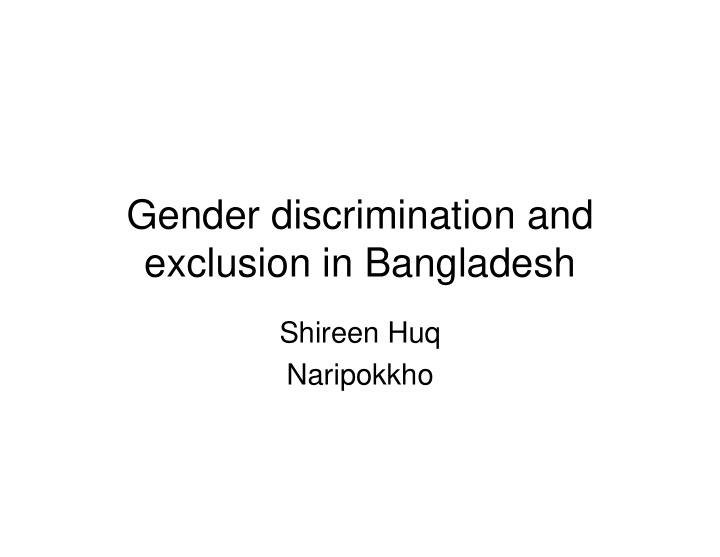



Gender discrimination and exclusion in Bangladesh Shireen Huq Naripokkho Naripokkho
The poor, and in particular the rural poor are excluded, exploited & discriminated against. l d d l it d & di i i t d i t • They are the most frequently excluded They are the most frequently excluded from development activities, growth centres, markets, information highways, centres markets information highways service facilities, etc • Physically distant • Physically distant – remote, and remote and structurally peripheral • They have little or no information on rights Th h littl i f ti i ht and opportunities
• Chronic insecurity most serious affliction of • Chronic insecurity most serious affliction of the poor • Chronic insecurity prevents enterprise, Ch i i it t t i asset formation and above all the development of a collective identity and d l t f ll ti id tit d interest
Poor women are the most voiceless, most disadvantaged, most excluded and most disadvantaged, most excluded and most insecure • Discrimination against women widespread Discrimination against women widespread and systemic • Discrimination reinforced by social norms • Discrimination reinforced by social norms and religious values • Women have little knowledge about rights W h littl k l d b t i ht and least able to express, assert or claim th them
Labour Market Labour Market • Highly segregated along gender lines Highly segregated along gender lines • Clear evidence of wage discrimination against women against women • Entry of large numbers of women in to l b labour force has not changed market f h t h d k t structures in favour of women
Class prejudice, urban bias & sexism alive and well i li d ll • Several decades of policy attention and Several decades of policy attention and special programmes for women’s development has borne some fruit development has borne some fruit • Women’s conditions have improved over time time • But their position remains subordinate to men
Livelihood struggles of poor women – migration in search of income i ti i h f i • Remittance one of the most important sources of revenue & foreign exchange for Bangladesh • Bulk of migrant workers are male, number of women few but significant f b t i ifi t • Cases of abuse of migrant women workers led t to temporary clamping down on women’s t l i d ’ migration • Women returnees face greater problems in re • Women returnees face greater problems in re- integration
Some small steps that can go a long way….backward linkages and support systems to ensure a rightful place for women in the labour market i th l b k t • Government to invest in safe migration for women & identify new markets women & identify new markets • Women migrant workers need support from Embassy staff, recruitment agencies, employers y , g , p y • Women workers need info on rights and negotiating skills • Transnational support groups can influence buyers, employers, agents.
• Increase the pool of women workers with • Increase the pool of women workers with skills and basic education • Donors need to consider long term D d t id l t planning as social and cultural barriers t k take time ti • Government and donors need to shift away from quick fixes to considering complex, multi-sectoral packages with long time frames in order to address discrimination and exclusion.
• With global recession making its way in to With global recession making its way in to the developing world, development assistance has an even more important assistance has an even more important role to play in order to ensure that it will not be business as usual, and that the not be business as usual, and that the excluded will not forever remain excluded. And even more so if the quantum of ODA d e e o e so t e qua tu o O goes down.
Recommend
More recommend